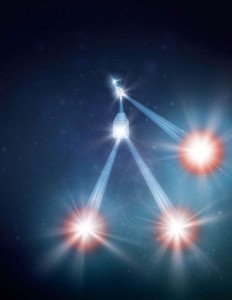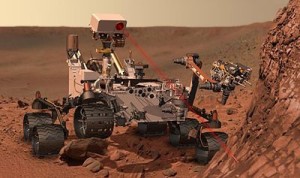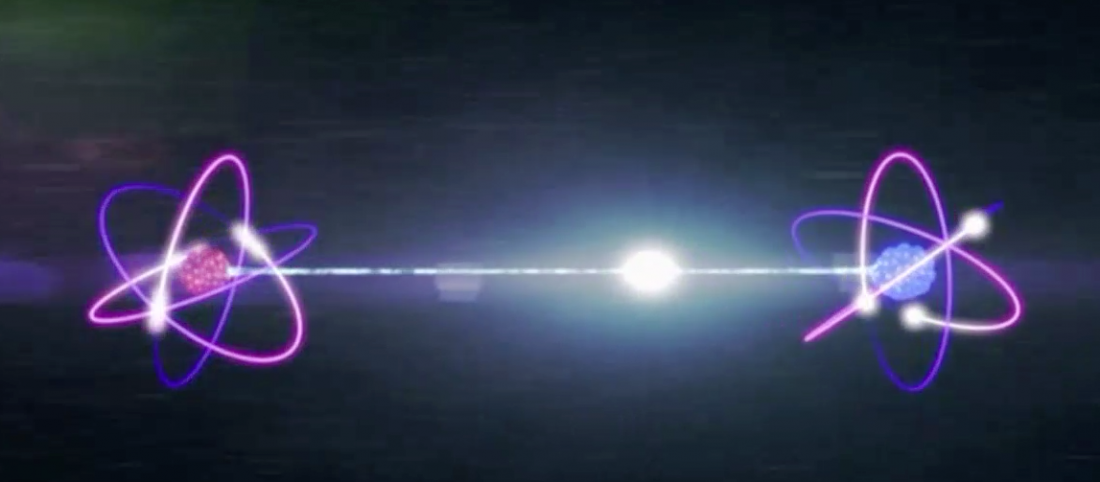Communicating with distant spacecraft in the solar system is cumbersome and time consuming because the distances are huge and no one can send signals faster than the speed-of-light. A signal from Earth can take from three to twenty-two minutes to reach Mars depending on the position of the two planets in their orbits. Worse, the Sun blocks signals when it lies in their path.
As countries explore farther from Earth to Mars and beyond, these delays and blockages will become annoying. The need to develop a technology for instantaneous communication that can penetrate or bypass the Sun will become compelling.
Quantum particles are known for their ability to “tunnel” through or ignore barriers — as they clearly do in double-slit experiments where electrons are fired one at a time to strike impossible locations. So, looking to quantum processes for signaling might be good places to start to find solutions to long-range communication problems.
NOTE FROM THE EDITORIAL BOARD, May 8, 2019: Sixteen months after Billy Lee published this post, the Chinese launched the Mozi satellite. It successfully carried out the first in a series of experiments with entangled quantum particles over space-scale distances. This technology promises a quantum encrypted network by the end of 2020 and a global web built on quantum encryption by 2030. The Chinese seem to be on the cusp of both FTL communication (through teleportation of information) and quantum encryption.
If scientists and engineers are able to develop quantum signaling over solar-system-scale distances, they might discover later that adding certain tweaks and modifications will render the Sun transparent to our evolving planet-to-planet communications network.
Indeed, the Sun is transparent to neutrinos — the lightest (least massive) particles known. In 2012, scientists showed they could use neutrinos to send a meaningful signal through materials that block or attenuate most other kinds of subatomic particles.
But this article is about faster than light (FTL) communication. Making the Sun transparent to inter-planetary signaling is best left for another article.
Quantum entanglement is the only phenomenon known where information seems to pass instantly between widely placed objects. But because the information is generated randomly, and because it is transferred between objects that are traveling at speeds at or below the speed-of-light, it seems clear to most physicists that faster-than-light (FTL) messaging can’t come from entanglement, certainly, or any other process — especially in light of Einstein’s assertion of a cosmic speed-limit.
Proposals for FTL communications based on technologies rooted in the quantum process of entanglement are usually dismissed as crack-pot engineering because they seem to be built on fundamental misunderstandings of the phenomenon.
Difficulties with the technology are often overlooked — such as spontaneous breaking and emergence of entanglement; progress seems impossible to skeptics. Nevertheless, there may be ways to make FTL happen, possibly. The country that develops the technology first will accrue advantages for their space exploration programs.
In this essay I hope to explain how FTL messaging might work, put my ideas into a blog-bottle and throw it into the vast cyber-ocean. Yes, the chances are almost zero that the right people will find the bottle, but I don’t care. For me, it’s about the fun of sharing something interesting and trying to explain it to whoever will listen.
Maybe a wandering NSA bot will detect my post and shuffle it up the chain-of-command for a human to review. What are the odds? Not good, probably.
Anyway, two serious obstacles must be overcome to communicate instantly over astronomical distances using quantum entanglement. The first is the problem of creating a purposeful signal. (To learn more about entanglement click the link in this sentence to go to Billy Lee’s essay, Bell’s Inequality. The Editors)
The second problem is how to create the architectural space to send signals instantly to a distant observer. Knowledgeable people who have written about the subject seem to agree that both obstacles are insurmountable.

Why? It’s because the states of an entangled pair of subatomic particles are not determined until one of the particles is measured. The states can’t be forced; they can only be discovered — and only after they are created by a measurement.
Once one particle’s state is created (randomly) through the mechanism of a measurement, the information is transferred to the entangled partner-particle instantly, yes, but the particles themselves are traveling at the speed-of-light or less. The randomly generated states carried by these entangled particles aren’t going anywhere for very long faster than the speed-limit of light.
How can these difficulties be overcome?
Although the architectural problem is the most interesting, I want to address the purposeful-signal problem first. A good analogy to aid understanding might be that of an old-fashioned typewriter. Each key on a typewriter when pressed delivers a unique piece of information (a letter of the alphabet) onto a piece of paper. A person standing nearby can read the message instantly. Fair enough.
Imagine setting up a device which emits entangled pairs of photons; rig the emissions so that half the photons when measured later will be polarized one way, half the other. No one can know which photons will display which state, but they can predict the overall ratio of the two polarities from a “weighted” emitter.
Call the 50/50 ratio, letter “A”. Now imagine configuring another emitter-system to project 3 of 4 photons polarized one way; 1 of 4 another — after measurement. Call the 3 to 1 ratio “B”. If engineers are able to construct and rig weighted emitters like these, they will have solved half of the FTL communication problem.
Although no one can know the state of any single particle until after a measurement, engineers could identify the ratio of polarization states in a large number sent from any of the unique emitter-configurations they design.
This capability would permit them to build a kind of typewriter keyboard by setting up photon emitters with enough statistical variation in their emission patterns to differentiate them into as many identifiable signatures as needed — perhaps an entire alphabet or — better yet — some other symbolic coding array like a binary on-off signaling system perhaps. In that case, one configuration of emitter would suffice, but designers would need to solve other technical problems involving rapid signal-sequencing.
To send a purposeful-signal, engineers might select an array of emitters and rapid-fire photons from them. If they selected an “A” (or perhaps an “on”) emitter, 50% of the photons would register as being in a particular polarization state after they were measured. If they chose “B”, 75% would register, and so on. After measurements on Earth, the entangled bursts of particles on their way to Mars would take on these ratios instantly.
I believe it might be possible to build emitter-systems someday — emitter systems with non-random polarization ratios. If not, then as is sometimes said at NASA, Houston, we have a problem. FTL communication may not be designable.
On the other hand, if engineers build these emitters, then we can know for sure that when measured on Earth, the entangled photon-twins in the Mars-bound emitter-bursts will display the same statistical patterns; the same polarization ratios. Anyone receiving bundles of entangled-photons from these encoded-emitters will be able to determine what they encode-for by the statistical distribution of their polarities.
Ok. Assume engineers build these emitter-systems and set up a keyboard. How might they ensure that when someone presses a key the letter sent is seen immediately by a distant observer?
How might the architectural geometry of the communication space be configured?
This part is the most interesting, at least to me, because its success doesn’t depend on whether anyone sends a single binary-signal or a zoo of symbols — and it’s the most critical.
It does no one any good to instantly communicate polarization states to bunches of photons traveling at the speed of light to Mars. The signals take three to twenty-two minutes to get there, whoever tells them instantly what state to be in or not. We want the machines on Mars to receive messages at the same time we send them.
How can we do that?
Maybe the method is becoming obvious to some readers. The answer is: photons in Earth-bound labs aren’t measured until their entangled twins have had time enough to travel to Mars (or wherever else they might be going). Engineers will entrap on Earth the photons from each “lettered” emitter and send their entangled twins to Mars. The photons from each “lettered” emitter on Earth will circulate in a holding bin (a kind of information-capacitor), until needed to construct a message.
As entangled twins reach the Mars Rover (for example), anyone can “type-out” a message by measuring the Earth-bound photons in the particular holding bins that encode the “letters” — that is, they can start the process that takes measurements that will induce the polarization-ratios of the “lettered” emissions used to “type” messages. Instantly, the entangled particle-bursts reaching Mars will take on these same polarization-ratios.
I hear folks saying, Wait a minute! Stop right there, Billy Lee! No one can hold onto photons. You can’t store them. You can’t trap or retain them, because they are impervious to magnets and electrical fields. No one can delay measurements for five milliseconds, let alone five minutes or five days.
Well, to my mind that’s just a technical hurdle that clever people can jump over, if they set their minds to it. After all, it is possible to confine light for for short periods with simple barriers, like walls.
Then again, electrons or muons might make better candidates for communication. Unlike photons, they are easily retained and manipulated by electromagnetic fields.
Muons are short-lived and would have to be accelerated to nearly light-speed to gain enough lifespan to be useful. They are 207 times heavier than electrons, but they travel well and penetrate obstacles easily. (Protons, by comparison, are nine times heavier than muons.)
The National Security Agency (NSA) photographs every ship at sea with muon penetrating technology to make sure none harbor nuclear weapons. Muons are particles some engineers are already comfortable manipulating in designs to give the USA an edge over other countries.
We also have a lot of experience with electrons. Electrons are long-lived — they don’t have to be accelerated to near light-speeds to be useful. Speed doesn’t matter, anyway.
Entangled particles don’t have to travel at light-speed to communicate well, nor do they have to live forever. Particles only need enough time to get to Mars (or wherever they’re going) before designers piggyback onto their Earth-bound entangled partners to transmit instant-messages.

Even if it takes days or weeks for bursts of entangled-particles to travel to Mars (or wherever else), it makes no difference. Engineers can run and accumulate a sufficiently robust loop of streaming emissions on Earth to enable folks, soon enough, to “type” out FTL messages in real time whenever necessary.
As long as control of and access to the emitted particle-twins on Earth is maintained, people can “type out” messages (by measuring the captive Earth-bound twins at the appropriate time) to impose and transfer the statistical configuration of their rigged polarization ratios (or spins in the case of electrons or muons) to the Mars-arriving particle-bursts, creating messages that a detector at that far-away location can decode and deliver, instantly.
The challenge of instant-return messaging could be met by employing the same technologies on Mars (or wherever else) as on Earth. The trick at both ends of the communication pipe-line is to store (and if necessary replenish) a sufficient quantity of the elements of any possible communication in streaming particle-emission capacitors.
Tracking and timing issues don’t require the development of new technologies; the engineering challenges are trivial by comparison and can be managed by dedicated computers.
Discharging streaming information capacitors to send ordered instant messages in real-time is new — perhaps a path forward exists that engineers can follow to achieve instant, long-range messaging through the magic of quantum entanglement.
The technical challenges of designing stable entanglement protocols that will enable an illusion of instant messaging that is both useful and practical are formidable, but everything worth doing is hard — until it isn’t.
Billy Lee


